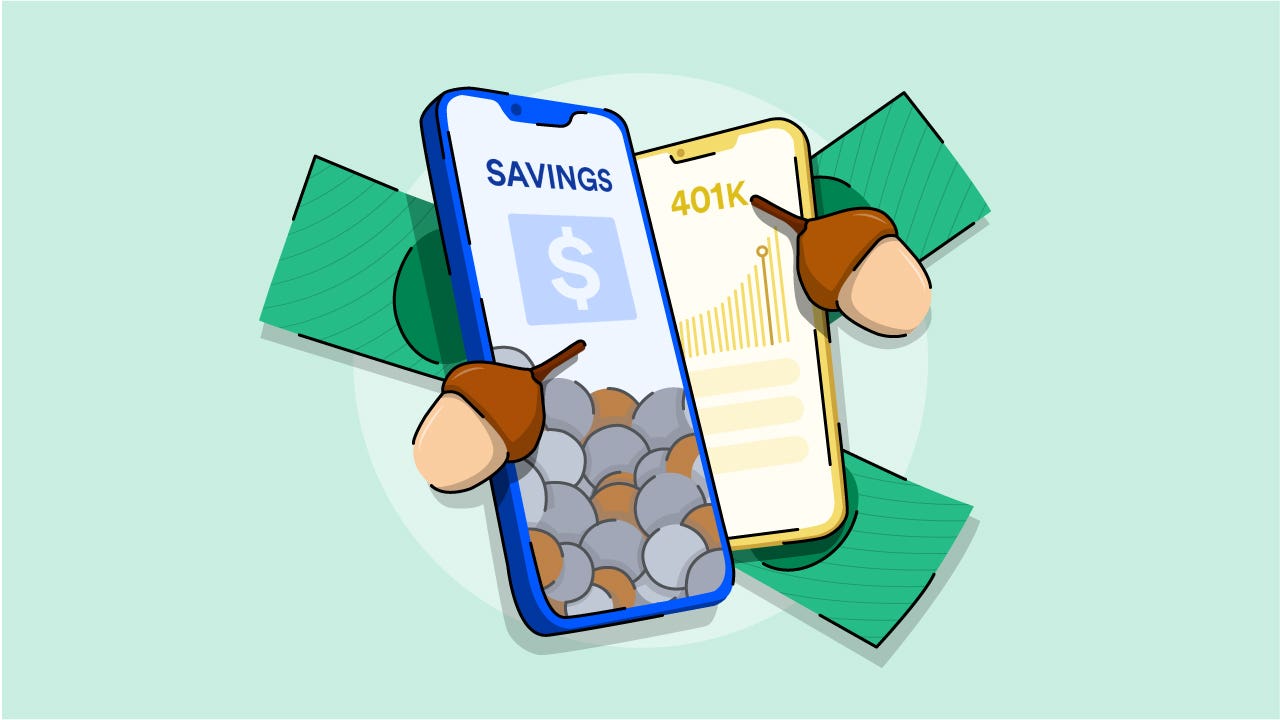6 ways to invest using your bills

If you’re looking to start saving and investing, you’re not alone. About 1 in 5 Americans have stated that investing is their biggest financial goal. Meanwhile, more than half of American workers said they feel behind on their retirement savings, meaning that catching up is likely a major priority.
It’s for a good reason that many Americans want to invest – $5 invested a day can grow into $150,000 by 2052 at a 6% annual return.*
Whether you’re looking to boost your 401(k) or start venturing into the stock market, investing as soon as you can is crucial to growing your money. However, growing bills and rising prices can mean spare cash to dedicate to investments is out of reach.
The good news is you don’t need a lot of money to start investing. With the strategies and resources offered by investment services like Acorns, you can use your bills as a springboard to launch your investment portfolio.
*Based on $155 invested monthly. This is a hypothetical investment calculation based on current market rates and historical trends; results may vary with contribution amount, rate of return and time period.
1. Use coupons and rebates to cash in at the grocery store
Grocery prices, in particular, have been hit hard by inflation, eating away at consumer earnings and spare cash. Coupon clipping can put some of that money back in your pocket and free up those funds to invest in your portfolio.
While you don’t need to dedicate hours of your life to hunting bargains, there are a few couponing strategies to max out your savings.
Firstly, look out for manufacturer coupons that you can combine with in-store coupons, meaning double the discounts. Secondly, look out for competitor or online price policies that allow you to match prices when shopping. Lastly, take advantage of store rain check dates. Rain checks allow you to stock up on discounted items in the future, which is especially helpful if prices rise again.
Rebates are another way to earn some cash back on your purchases. Depending on the rebate type, the more you spend at one store, the more potential cash you can earn back. This gives you a small windfall at a later date that you can use to invest.
You don’t have to limit yourself to shopping at one store, either. Some brands offer rebates through partners such as Acorns Earn, which can be another avenue to find deals.
2. Round up your purchases
Another simple way you can start investing is by rounding up your purchases and using the small change to invest. For example, if you buy a coffee for $4.77, you can round up the purchase to $5 and use the $0.23 to contribute to your portfolio.
While it’s possible to do this manually by tracking your transactions, rounding them up and investing the money after the fact, Acorns can automatically round up and invest for all the purchases you make on your selected charge account. This allows you to begin building your portfolio in the background.
3. Patch up money leaks and invest your savings
Is your wallet leaking? Unaccounted fees, charges and sneakily growing bills might not be noticeable at first glance, but they can slowly add up. Consider which everyday expenses are causing you to spend more money than you have to.
Bring up your month-to-month expenses and see where you can reduce your expenditures. If your utility bills have increased, you might want to find ways to cut down on heating, electricity and cooling costs – or check if there’s an insulation issue in your home. Additionally, make sure your car is in good working order for maximum fuel efficiency.
Reducing incidental expenses can also be a way to start investing, especially if you make it part of your routine. Investment apps like Acorns can allow you to invest with a click, meaning you can instantly reward yourself for skipping your daily coffee run.
Additionally, you can transfer a set amount of your direct deposits each month to your investment or savings accounts using features such as Acorns Smart Deposit.
4. Use card rewards for extra cash
Cash back rewards on your credit card mean that for every dollar you spend, you get some of that back. A card with 5 percent cash back can get you $50 for every $1,000 charged, which is extra cash you can divert to investing.
When it comes to searching for a cashback card, look for one that fits your spending habits. See if you can find a card with a welcome bonus, which can give you cash to work with immediately.
Some cards offer a flat rate of 1 percent with higher returns on certain categories of purchases, such as groceries or Amazon orders. Keep an eye on the categories your card specializes in. The more you run on your card, the more cash you’ll get, so aim for the categories in which you spend the most.
5. Turn an expense into passive income
With a little effort, money sinks, such as your car, gym memberships or buying supplies to fund your hobby, can actually be profitable. Monetizing a hobby can be a great way to recoup expenses and bring in a passive income stream for building your portfolio.
Side hustles can include recouping your car payment with ride sharing or food delivery, making good on your gym membership by becoming a personal trainer or breaking even on your mortgage payments by renting out a room.
You can monetize your side hobbies as well. If you’re into crafting or woodwork, selling your creations on Etsy can be an easy way to make some extra cash to invest. You can also start a tutoring service or coach an amateur sports team.
6. Look for tax deductions and credits you might be missing
Finally, tax deductions can be an easy way to max out your tax return. While you can’t access this form of cash immediately, deductions can give you a decent chunk of cash to work with once they’re processed and you receive your return.
Charitable donations are deductible in many cases. This may include monetary contributions, donated clothes or unreimbursed mileage for driving yourself to volunteer activities. If you run a small business, you can usually deduct expenses such as insurance, inventory and equipment leasing.
Start your investing journey with Acorns
Saving on costs can help free up your cash, and that extra cash can be used for investments. If you’re an investing beginner, venturing into the world of exchange traded funds, portfolios and dividends can seem scary. However, Acorns can provide you with both the means and resources to start off your investing journey on the right foot and build your knowledge and portfolio with confidence.
Acorns allows you to invest your spare change. Each purchase on your linked account will be rounded to the nearest dollar, allowing you to add to your investment funds with every bill you pay. Creating an account only takes five minutes.
You only need $5 in your Acorns account to start a portfolio selected by Acorns investment experts. The average Acorns customer invests $166 within four months – all from investing their everyday spare change.
Investment doesn’t have to stop there. As you build up your portfolio, you can learn about investing by using Acorns’ investing resources, which include expert articles, reviews, advice and news to keep up to date on the latest market trends.
Additionally, with the money you save from everyday expenses using the tips highlighted above, you can create accounts with Acorns for retirement, your family and more. This allows you to save and invest for the future while gaining potential tax advantages.
Subscription tiers start at only $3 a month for an Acorns personal account. Learn more about opening an Acorns account, as well as the associated disclosures, on Acorns.com.
The bottom line
It’s better to start investing sooner than later if you want to build a nest egg. Fortunately, one of the best ways to begin investing doesn’t require a windfall – investing with a little money is more possible now than ever. By analyzing your expenses, finding ways to save and getting creative, you can use your everyday expenses to start small and build your portfolio.
Acorns can help you launch your investing journey. The easy-to-use app invests from your everyday purchases, while providing educational resources to help build your knowledge. With a flexible system, it’s easier than ever to take the first step into the world of investing. See if Acorns is right for you.







